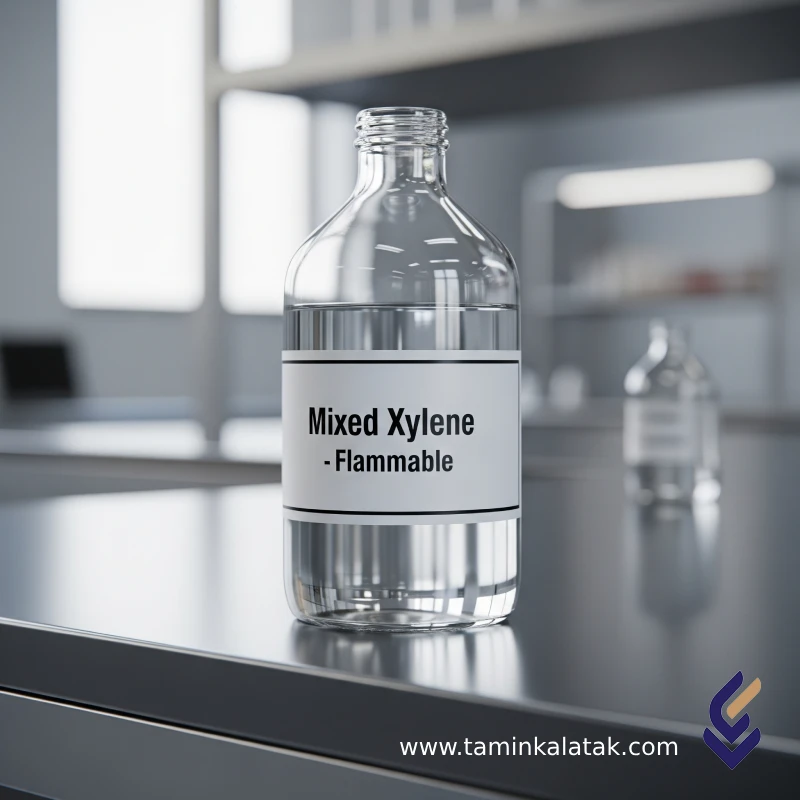Mixed xylene
Mixed xylene is an aromatic organic compound composed of three main xylene isomers — ortho-xylene (o-xylene), meta-xylene (m-xylene), and para-xylene (p-xylene) — along with a significant proportion (approximately 10–20%) of ethylbenzene.
This chemical is primarily used as a solvent in various industries and, due to its moderate volatility and chemical stability, is one of the most widely used solvents in the petrochemical, paint and resin, printing, and adhesive industries.
Structure of Mixed Xylene
Mixed xylene consists of the following three isomers:
-
Ortho-xylene (o-xylene)
-
Meta-xylene (m-xylene)
-
Para-xylene (p-xylene)
together with about 10–20% ethylbenzene.
General Chemical Formula: C₈H₁₀
Structure: A benzene ring with two methyl (–CH₃) groups attached at different positions.
Properties of Mixed Xylene
-
Chemical Formula: C₆H₄(CH₃)₂
-
Appearance: Colorless, clear liquid with a sweet, characteristic odor
-
Boiling Point: Approximately 138–144°C
-
Flash Point: About 27–30°C (highly flammable)
-
Solubility: Insoluble in water but soluble in organic solvents such as ethanol, ether, and acetone
Applications of Mixed Xylene
Mixed xylene has a wide range of applications, including:
-
As a solvent in the manufacture of paints, varnishes, inks, and thinners
-
In adhesive and resin formulations
-
In the petrochemical industry for producing para-xylene, a raw material for polyesters and PET bottles
-
As an extraction agent in laboratories
-
In the production of plastics, synthetic fibers (such as polyester), detergents, and pesticides
-
As a cleaning and degreasing agent in the metal and electronics industries
Advantages of Mixed Xylene
-
High solvency power for a wide range of organic compounds
-
Readily available and cost-effective
-
Excellent compatibility with industrial and chemical processes
-
Good chemical stability in various industrial applications
Disadvantages of Mixed Xylene
-
Highly flammable: Must be stored in a safe environment away from heat sources
-
Toxic vapors: Prolonged inhalation can cause headaches, dizziness, drowsiness, central nervous system damage, and respiratory issues
-
Environmental hazards: Leakage can contaminate groundwater and soil
-
Skin and eye irritation: Direct contact may cause dryness, inflammation, and irritation
Safety and Handling of Mixed Xylene
When handling mixed xylene, the following safety precautions should be observed:
-
Wear chemical-resistant gloves, safety goggles, and an appropriate respirator
-
Store in tightly sealed, solvent-resistant containers
-
Keep away from heat, sparks, and open flames
-
Work in a well-ventilated area to prevent vapor accumulation
-
In case of a spill, absorb with non-combustible materials (such as clay or sand) and dispose of according to environmental regulations
Applications
| Applications | , , , |
|---|
Mixed xylene
| Products | Chemical formula | CAS number | Grade | Vapor pressure | Physical appearance | Solubility in water | Melting point | Density (at 20°C) |
|---|---|---|---|---|---|---|---|---|
| Mixed Xylenes | C₆H₄(CH₃)₂ or generally C₈H₁₀ | 1330-20-7 | Industrial, laboratory (Reagent grade, ≥99%) | 6–9 mmHg | Clear, colorless liquid with a sweet, characteristic odor. | Very slightly soluble (<0.02 g/100 mL at 25°C) | About –47 to –54 °C | 0.86–0.88 g/cm³ |







